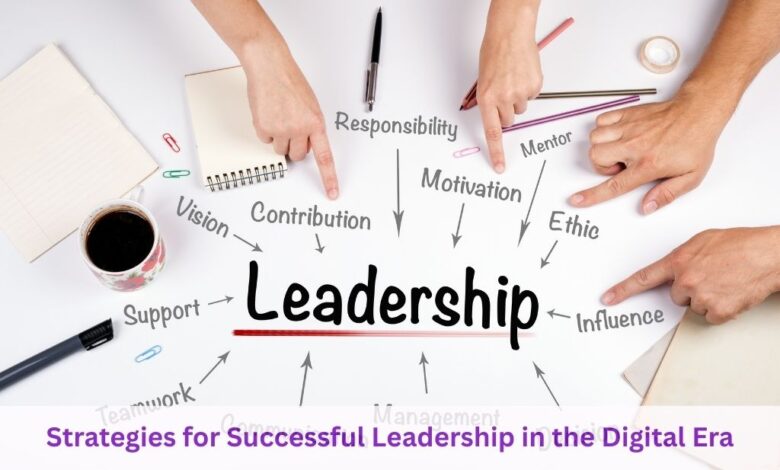Strategies for Successful Leadership in the Digital Era

Preface Rapid growth in digital technology has revolutionized how companies communicate, contend, and operate. The same applies to leadership dynamics too. Effective leadership in the digital age requires inflexibility, technology proficiency, and the capability to motivate and guide brigades through nonstop change more than bare traditional operation chops. This composition presents significant strategies for good leadership in the digital age, furnishing sapience into how directors can thrive and manage their businesses to substance in a society getting decreasingly digital.
Espousing Digital knowledge
Increased digital knowledge is one of the abecedarian styles of current effective leadership. To be suitable to make informed opinions and effectively guide their brigades, leaders must have a good understanding of digital tools, channels, and trends. Being Informed Leaders need to stay up to date with arising technologies similar as artificial intelligence( AI), machine literacy( ML), blockchain, and pall computing.
For illustration, Satya Nadella, the CEO of Microsoft, has emphasized the significance of integrating artificial intelligence across Microsoft products, therefore situating the company at the van of technological advancement. nonstop literacy Encouraging an organisational culture of ongoing literacy ensures sustained competitiveness.
For case, Google offers in- house training programs to reskill workers and foster creativity. Leaders who share tête-à-tête in similar enterprises set a good illustration and encourage others to do the same.
Encouraging a Culture of Innovation In the information age, invention is a primary motorist of growth. Leaders must produce an terrain where trials and ideas are encouraged.
Encouraging threat Taking Amazon author Jeff Bezos formerly stated,” If you double the number of trials you make per time, you’re going to double your inventiveness. Good leaders make brigades explore new results and threat- taking. Fail Fast, Learn Faster Leaders must foster a culture where failure is seen as a literacy occasion. In companies similar as Tesla, the relinquishment of rapid-fire prototyping and iterative development facilitates invention.
Idea Incubation structure internal platforms like hackathon or invention labs allows workers to submit and develop ideas. A great illustration of the same is Atlassian’s” ShipIt Days,” where workers are given 24 hours to develop any design they choose. Leveraging Data- Driven Decision Making Data happens to be a veritably potent armament in the moment’s digital world.
Great leaders formulate plans and make opinions grounded on data analysis. Leaders should be comfortable with using analysis tools similar to Tableau, Power BI, or Google Analytics. Understanding trends in data helps to have strategic foresight and effective resource planning.
Netflix is an awful illustration of a company enhancing its services by studying client data.Data is the driving force behind its recommendation machine, which supports client retention and satisfaction. directors should establish crucial performance pointers( KPIs) to track progress. Deals conditioning, customer relations, and trend prognostications are tracked by Salesforce via dashboards, for illustration. Fostering online collaboration Virtual collaboration is more critical than ever with global brigades and remote work on the rise. Applying digital technology similar as Slack, Zoom, Microsoft brigades, and Asana assists to grease effective design operation and communication among brigades.
Adobe encourages virtual platoon- structure conditioning and regular check- sways to help to foster fellowship. By being open, communicating regularly, and celebrating platoon triumphs, trust is erected. Leaders must ensure that each voice of every platoon member, no matter the part or position, is heard.
Cyber security
This requires inclusive meeting styles, indifferent recognition systems, and spaces for review. Raising Cybersecurity knowledge As companies continue to calculate more on digital architectures, security becomes a prominent concern.
Cybersecurity Training Human mistakes contribute to 95% of the security breaches, according to IBM. directors must ensure that their workers are handed regular training in handling data, managing watchwords, and phishing. Enhancing and enriching cybersecurity programs eliminates implicit pitfalls via threat operation. enterprises like Cisco have special cybersecurity programs which are regularly anatomized and bettered upon. Leaders set an excellent illustration for their brigades by demonstrating responsible gets.
Like the use of safe watchwords and reporting suspicious exertion. Champion Diversity and Addition The digital revolution is n’t simply briskly processors and hipster interfaces; it’s each about people. Imagine the internet as a sprawling, worldwide web of mortal creativity.
That is the true eventuality, and visionary leaders are employing it. The digital age with its measureless connectivity provides a great chance to gather together great minds from across the world, across culture and background, like no way ahead. Make opinions Grounded on Data These directors are not simply paying lip service to diversity; they are laboriously championing for addition. Why? Because different brigades are, relatively literally, invention machines. It’s like having a culinary work of art: a dish is only as good as the distinctive constituents that produce it.
Each sapience, each experience, contributes a special flavor to the pot, performing in a commodity truly outstanding. And it’s not just about having a different platoon; it’s about icing everyone feels heard, valued, and empowered to contribute their unique bents. That is the magic of addition. Stay Ethical and Responsible: how do these leaders produce these inclusive societies? It’s a complex process, a thoughtful collaboration of a number of crucial rudiments. They laboriously work to overcome unconscious bias in hiring and elevations, leveling the playing field for all. They encourage cooperation among different groups, erecting a synergistic culture where different views can crash and enkindle new ideas.
Lead by Example
In this hyperactive-connected, globalized digital frugality of the moment, addition and diversity are not simply immorally correct; they are a matter of strategic necessity. They are not simply a nice- to- have; they are an imperative for survival and success. Businesses that come to grips with this reality will be poised for lesser success, further invention, and eventually, further continuity. It’s a palm- palm – for the business, for the workers, and for the world generally. It’s creating a future where everyone has a seat at the table, and their voice is n’t only heard, but also celebrated.
The magic of addition .
These leaders are not simply making political speeches about diversity; they are actually championing for addition. Why? Because different brigades are, relatively simply, invention boots-trappers. It’s like having a culinary masterpiece: a dish is only as good as the unique constituents that go into it. Each perspective, each background, brings a unique flavor to the pot, leading to a truly exceptional.
And it’s not just about having a different platoon; it’s about icing everyone feels heard, valued, and empowered to contribute their unique bents. That is the magic of addition.
Promote collaboration
So, also, how do these leaders construct these inclusive societies? It’s a multifaceted process, a sensitive choreography of several crucial constituents. They proactively fight unconscious bias in reclamation and creation, furnishing a position playing field for all. They promote collaboration within different groups, creating a synergistic setting where different ideas can crash and en-kindle new results. And critically, they laboriously hear to and amplify the voices that are frequently overlooked, the perspectives that might else remain unheard.
Digital frugality
In a moment’s hyperactive- connected, globalized digital frugality, diversity and addition are not just innocently right, they’re a strategic imperative. They are not just a nice- to- have; they are a necessity for survival and thriving. Businesses that accept this reality will be better equipped for success, more creative, and eventually, more flexible. It’s a palm- palm for the business, for the workers, and for the world as a whole.
It’s about creating a future where everyone gets a seat at the table, and their voice is n’t only heard, but celebrated.
This dynamic terrain has converted the way associations operate, communicate, and introduce. In this dynamic terrain, effective leadership requires a mix of traditional operation chops and ultramodern technological ignorance. Leaders must n’t only acclimatize to rapid-fire changes but also guide their brigades through digital transitions with clarity and confidence.
Elaboration of technology
One of the most important digital leadership strategies is espousing ongoing literacy. The rapid-fire development of technology requires leaders to stay ahead of the wind on forthcoming trends, tools, and platforms. This way, leaders can make educated opinions and lead by illustration on a culture of curiosity and inflexibility for their brigades. Another important strategy is to make a digital-first culture. Leaders need to promote the application of digital tools to maximize productivity, optimize operations, and enhance client experience. This includes not only making technology investments but also offering training and support so that brigades can effectively work digital coffers.
Make effective communication:
Effective communication is now more critical than ever with the digital period. With remote working and virtual brigades getting increasingly common, leaders need to be complete in digital communication channels and make translucency and trust. harmonious, clear messaging and active listening can serve to bridge the gaps that physical distance creates.
Association’s Success
Dexterity and adaptability are also rates that are necessary for moment’s leaders. The digital terrain is generally turbulent, and the capacity to turn snappily in response to challenges or openings can make or break an association. Leaders ought to enable their brigades to try and fail, learn from trial, and introduce bravely. Incipiently, ethical leadership and data responsibility are gaining elevation.
As large volumes of data are being gathered and reused, leaders need to ensure that sequestration, security, and ethical enterprises are at the center of digital strategies. Creating a culture of integrity and responsibility is pivotal to maintaining stakeholders’ trust. Eventually, successful leadership in the digital age demands a multinational approach, which integrates specialized moxie, learning on a sustained basis, good communication, and ethical responsibility. By embracing similar strategies, leaders can motivate their brigades and direct their associations to long- term achievement in a fast- changing digital period.




